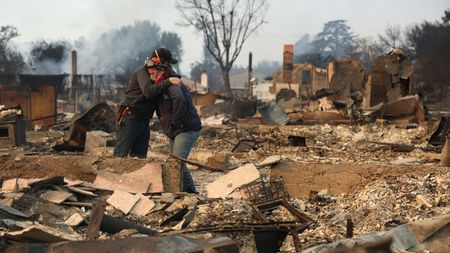What Is Liability Insurance and What Does It Cover?
Liability insurance is mandatory in almost every state to pay for damages or injuries in car accidents where you're at fault.

Rachael Green
As you look for ways to lower your premiums, liability insurance is not one you want to skimp on. Car liability insurance is mandatory in most states. But it can also be a financial lifesaver, protecting you from forking out thousands for repairs and medical bills if you're found at fault in an accident.
Liability pays out when you hit someone or something with your vehicle. It can help cover an injured person's medical bills, repairs to someone's vehicle or fix damage to property.
While drivers in most states are legally required to carry some form of liability insurance, it may be worth getting more than the minimum required coverage in some cases. Keep reading to learn more about what car liability insurance covers and how to calculate the amount of coverage you need.

Sign up for Kiplinger’s Free E-Newsletters
Profit and prosper with the best of expert advice on investing, taxes, retirement, personal finance and more - straight to your e-mail.
Profit and prosper with the best of expert advice - straight to your e-mail.
What is car liability insurance?
Basically, liability coverage is the part of your auto insurance policy that pays for the other driver's expenses if you are found at fault in a car accident. It does not, however, cover your own damages or injuries.
There are two main types of liability coverage: bodily injury and property damage. If you're found at fault in an car accident, bodily injury liability helps cover the other person's medical bills while property damage liability coverage pays for the repairs to their car or other property.
Don’t forget that your property damage liability insurance won’t cover the cost of repairing your car if you’re in an accident. Likewise, your bodily injury liability insurance doesn’t cover your own medical bills if you’re injured in a collision. Instead, it covers the injuries or damage that you cause to another person in an accident. Liability coverage protects your financial well being, not your body or your property.
In some states, a third type of liability coverage, called uninsured/underinsured motorist coverage, is also required. This type of car insurance kicks in when the other driver is at fault but doesn't have insurance or doesn't have enough coverage to pay for the repairs or medical care you need.
What is covered by bodily injury liability insurance?
Bodily injury liability coverage helps pay the costs for anyone that is injured in a car accident where you're found liable. This may include a driver or passengers in another car, pedestrians or unrelated passengers in your own car. It covers medical expenses, compensation for lost wages and income and legal fees.
For instance, say you run a red light and strike another car, injuring the driver. Your liability coverage obliges the insurance company to defend you — in court, if necessary — and pay claims to the other driver for vehicle damage and bodily injuries, including medical and hospital costs, rehabilitation, nursing care, and possibly lost income or money for pain and suffering.
What is covered by property damage liability insurance?
Property damage liability coverage helps pay for damage you cause to another person's vehicle or property. If you hit someone else's car, front porch or mailbox with your car, property damage liability coverage may help pay to repair their property.
What is uninsured/underinsured motorist insurance?
Only about half of states require some form of uninsured/underinsured motorist insurance, but it’s in your and your passengers' best interests to think seriously about buying this coverage regardless of state mandates. Unlike liability insurance, this coverage can help pay your expenses.
In accidents where you aren't found at fault, it covers your injuries, your passengers' injuries, and damage to your vehicle if you're hit by a driver who has no auto insurance coverage or whose liability coverage is too low to cover the full cost of repairs and medical bills.
It may also cover hit-and-run accidents, when you weren't able to get the driver's insurance information. So, if a driver hits your vehicle and flees, you can file a claim against your policy's uninsured motorist coverage.
What are minimum car insurance requirements state-to-state?
Minimum car insurance requirements vary from state to state. But state requirements are generally modest — typically $20,000 to $30,000 for bodily injury suffered by one person in an accident, $50,000 for all people hurt in the same accident, and up to $25,000 for property damage resulting from that accident.
A state's required minimum merely keeps you in compliance with state law. If you're found liable for more damages than your policy limits will cover, you're on the hook for the rest. So, most drivers need more than the minimum coverage to avoid paying out of pocket in a car accident where they're at fault.
While some states have higher car insurance rates than others, nearly all states have some sort of mandate related to car liability insurance coverage. New Hampshire is the only state that does not have these mandates, but you would still be on the hook for damages and injuries if you're found at fault in this state, so car insurance is strongly recommended.
As of July 1, 2024, drivers in Virginia no longer have the option to pay a $500 uninsured motor vehicle fee to register their non-insured vehicle. The Virginia Department of Motor Vehicles (DMV) now requires all drivers to carry minimum liability insurance.
How much liability coverage do you have?
Insurance companies use a shorthand to describe their liability coverage, and even if you understand the lingo, it might not be immediately apparent how much coverage you actually carry right now.
For instance, a policy might be listed as 50/100/25. Here is what those numbers mean:
- The first number refers to the coverage limit, in thousands of dollars, for bodily injury per injured person.
- The second number is the total per-accident limit for injuries to all people in the same accident
- The third number is the coverage limit for property damage in the same accident
So, if your liability coverage is listed in your policy as 50/100/25, your insurer would pay up to $50,000 per person or $100,000 total for everyone if there is more than one injured person. Then, it would pay up to $25,000 to repair the car or other property damaged in that accident.
If the medical bills or damages end up being higher than those coverage limits, you have to pay the rest out of pocket.
Some companies issue single-limit policies. Instead of three numbers, you'll see one number representing the total amount your insurer will pay to cover injuries and property damage, regardless of the number of people or vehicles involved.
If the insurance company incurs legal expenses to defend you against a lawsuit, those expenses don't count toward the liability limits. Nor do payments you receive under the policy for bail bonds and earnings lost while attending hearings and trials at the company's request.
How much coverage do you need?
You should carry as much liability coverage as you can comfortably afford because damage claims today are sometimes settled for millions. State minimums don't come close to covering the cost of a serious accident.
Remember, any damages that go beyond the limits of your policy are still your responsibility, which means your home, your vehicles, and any other assets you have could be at risk if you are taken to court over an at-fault accident.
Insurers recommend that your liability coverage exceed your net worth. To calculate your net worth, add up the value of your biggest assets, like your home, cars, retirement accounts and savings. Then, subtract any debts, like your mortgage, car loan, and credit card balances.
Setting your liability coverage just above your net worth protects those valuable assets from being taken in court to settle the outstanding balance owed in the accident.
Say you estimate you current net worth is $280,000. In that case you would want a 100/300/100 policy. This provides bodily-injury coverage of at least $100,000 per person, and $300,000 per accident, as well as property-damage coverage of $100,000. If you have a single-limit policy, you'd want a minimum of $300,000 liability coverage.
Raising your limits isn't expensive. $300,000 in coverage costs 20% more than $100,000, on average. The more coverage you buy, the less you have to pay per $1,000 of coverage. Ask your agent for precise figures.
Boost your liability coverage with umbrella insurance
Depending on your assets and net worth, it might make more sense to buy umbrella insurance instead of maxing out the liability coverage on your car insurance. Umbrella insurance provides additional liability coverage in cases where you've exceeded your car or home insurance's limits.
Many car insurance policies only offer up to $500,000 in liability coverage. If your total assets are worth more than that, you might be better off reducing liability coverage to the minimum allowed and then buying additional umbrella insurance to protect the rest of your assets. Just note that insurers typically require you to meet certain liability limits on your underlying policy before adding umbrella insurance.
Related Content
Get Kiplinger Today newsletter — free
Profit and prosper with the best of Kiplinger's advice on investing, taxes, retirement, personal finance and much more. Delivered daily. Enter your email in the box and click Sign Me Up.

Donna joined Kiplinger as a personal finance writer in 2023. She spent more than a decade as the contributing editor of J.K.Lasser's Your Income Tax Guide and edited state specific legal treatises at ALM Media. She has shared her expertise as a guest on Bloomberg, CNN, Fox, NPR, CNBC and many other media outlets around the nation. She is a graduate of Brooklyn Law School and the University at Buffalo.
- Rachael GreenPersonal finance eCommerce writer
-
 Social Security Under Trump: Live Updates to Keep You Up to Date
Social Security Under Trump: Live Updates to Keep You Up to DateSocial Security Blog Social Security is undergoing big changes in 2025 under President Trump. Get live daily news, updates, tips and analysis to help you navigate the developments.
By Donna LeValley Published
-
 Stock Market Today: Auto Tariffs Send Stocks Lower
Stock Market Today: Auto Tariffs Send Stocks LowerThe main indexes snapped their win streaks after the White House confirmed President Trump will talk about auto tariffs after the close.
By Karee Venema Published
-
 10 States with the Cheapest Home Insurance in 2025
10 States with the Cheapest Home Insurance in 2025Homeowners in these 10 states pay at least $1,000 less than the national average for home insurance.
By Rachael Green Published
-
 How to Re-Shop for Home Insurance
How to Re-Shop for Home InsuranceHomeowners nationwide are facing rising home insurance costs and policy cancellations. Learn how to compare providers, find savings and ensure your home remains protected.
By Dori Zinn Published
-
 Borrowing Against Your Life Insurance: How It Works and What to Consider
Borrowing Against Your Life Insurance: How It Works and What to ConsiderUnlock quick access to cash by borrowing against your life insurance policy — without credit checks or strict repayment terms.
By Dori Zinn Published
-
 Luxury, Exotic and Classic Car Insurance: How To Get the Best Coverage
Luxury, Exotic and Classic Car Insurance: How To Get the Best CoverageLearn how to insure a luxury or exotic car without overpaying. Compare rates, maximize discounts, and find the best coverage options for high-end vehicles.
By Jacob Wolinsky Published
-
 4 Ways to Lower Your Home Insurance Premium in 2025
4 Ways to Lower Your Home Insurance Premium in 2025Learn how to reduce your homeowners insurance premiums with these four effective strategies.
By Jacob Wolinsky Published
-
 State Farm Seeks Emergency Insurance Rate Hikes in California After Wildfires
State Farm Seeks Emergency Insurance Rate Hikes in California After WildfiresState Farm has requested emergency rate increases of up to 38% in California, citing wildfire-related losses. Here’s what homeowners need to know.
By Carla Ayers Published
-
 What To Know if You’re in the Market for a New Car This Year
What To Know if You’re in the Market for a New Car This YearThe Kiplinger Letter Buying a new car will get a little easier, but don’t expect many deals.
By David Payne Published
-
 Do Wildfires Have You Worried About Your Insurance Coverage? Here's What to Do
Do Wildfires Have You Worried About Your Insurance Coverage? Here's What to DoWith the California wildfires causing billions of dollars in damage, now is a good time to assess your homeowner's insurance and ensure it covers disasters.
By Sean Jackson Published